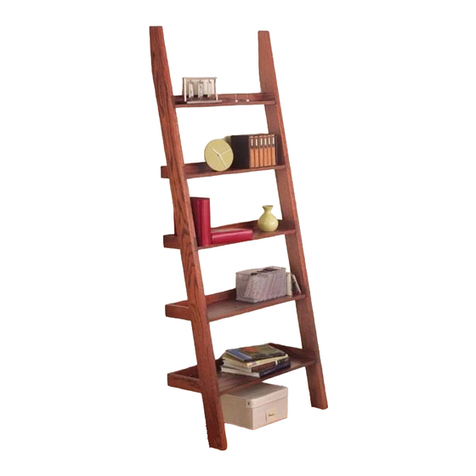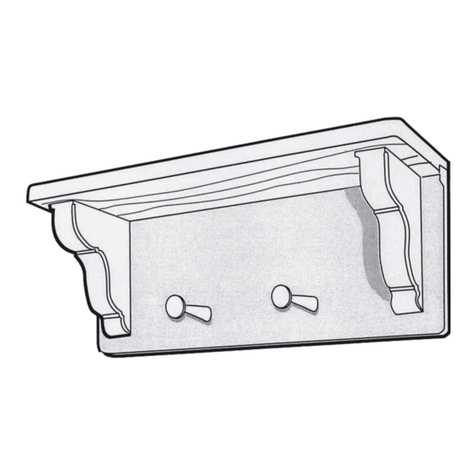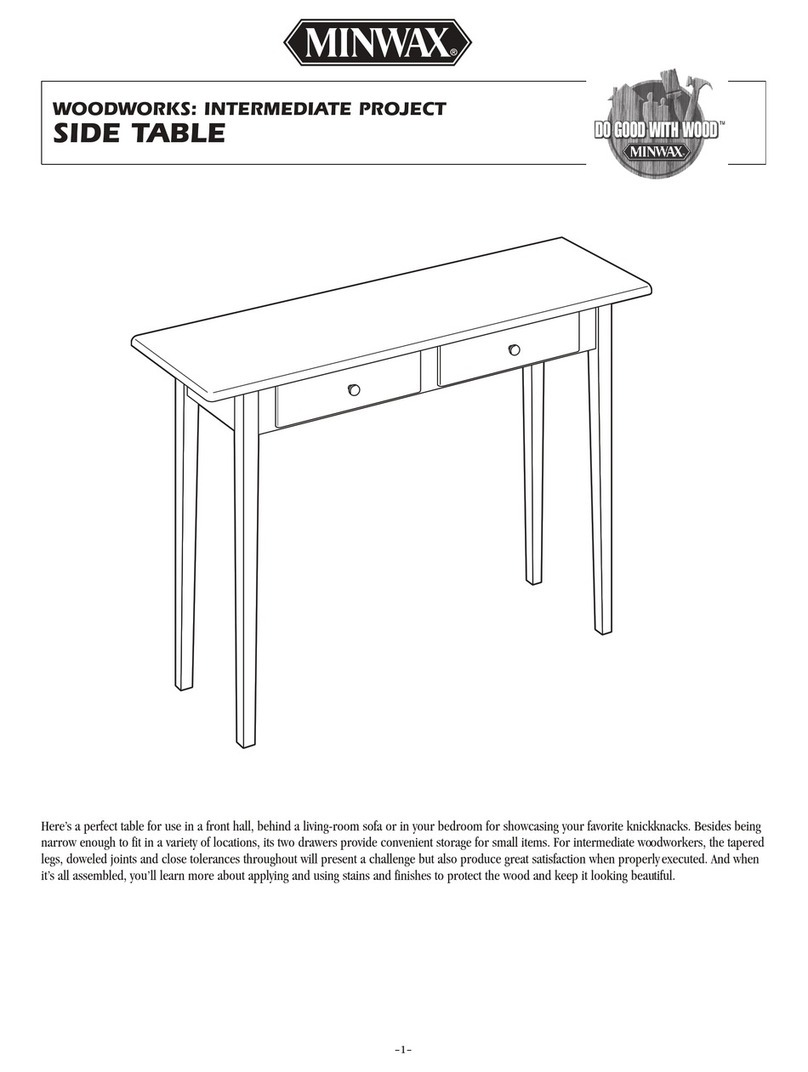
–5–
CONTINUED - WOODWORKS: ADVANCED PROJECT 2009-2010 PATIO TABLE
FINISHING TIPS
• Coverage: The approximate coverage of Thompson’s®WaterSeal®
Advanced Tinted Wood Protector and Thompson’s®WaterSeal®
Waterproofer Plus Tinted Wood Protector on pine is 200 square feet
per gallon.
• When you apply Thompson’s®WaterSeal®Advanced Tinted Wood
Protector or Thompson’s®WaterSeal®Waterproofer Plus Clear or
Tinted Wood Protector, do not mix it with other waterproofing prod-
ucts, because variations in the final appearance of the surface being
treated may result. Also, do not thin these products.
Recommended Finish
For the best protection against sun and water damage, use
Thompson’s®WaterSeal®Advanced Tinted Wood Protector
(also available in Natural).
50. Before applying Thompson’s®WaterSeal®Advanced Tinted Wood
Protector, the wood surface must be free of all dirt, wood dust and
contaminants. This product can be applied to damp, freshly cleaned
wood. If the wood needs cleaning, use Thompson’s®WaterSeal®
Deck Cleaner & Brightener or Thompson’s®WaterSeal®Deck Wash.
Read and follow the directions found on the back of the can. After the
cleaning is done, read and follow the directions found on the back
of the can of the Tinted Wood Protector. Then do a trial test before
full application. The surface may darken slightly with application and
color appearance is different when the wood is fully dry.
51. To ensure good penetration, do not apply this product in
direct sunlight or on hot days. Do not apply if rain is expected
within 48 hours. Also, temperature must be above 50º F. and
below 95º F. and remain above freezing for 24 hours.
52. Shake or stir contents for a minimum of 2 minutes before use.
Intermix all containers (of the same color) to be used to assure color
uniformity.
53. Apply using a paint pad or brush. Do not apply using a roller. For
small projects, a brush is the preferred applicator.
54. Apply only one thin, even coat. DO NOT APPLY A SECOND COAT.
A heavier or additional coat will not improve performance or appear-
ance. Avoid puddling. Tackiness will result if overapplied. Tackiness
may also occur after application if overnight temperature falls below
50°F. within 48 hours of application. Drying time will vary depending
on wood surface and humidity. Allow a minimum of 12 hours before
using the table.
55. Brushes and equipment used for water-based products must be
cleaned with soap and water; brushes used for oil-based finishes must
be cleaned with mineral spirits. Dry product can be removed with
mineral spirits.
Alternate Finish
56. Before applying Thompson’s®WaterSeal®Waterproofer Plus
Tinted Wood Protector Sheer Honey Gold, read and follow the
directions found on the back of the can. Be sure that both surface and
air temperature are above 50° F. during application and for 48 hours
after application. And, if you’re working outside, do not apply product
if rain is forecasted within 24 hours of application.
57. The surfaces must be free of all dirt, wood dust and all other
contaminants. To clean the wood, use either Thompson’s®WaterSeal®
Deck Cleaner & Brightener or Thompson’s®WaterSeal®Deck Wash.
If the surface is damp or wet from cleaning or weather, allow the sur-
face to dry thoroughly (a minimum of 48 hours) before application.
58. Do not mix the product with other waterproofing products
because variations in the final appearance of the surface being
treated may result.
59. Before applying the product over the entire surface, a small trial
patch is recommended.
60. In most applications, only one light coat is necessary. Apply with
a brush, roller or applicator pad. Regardless of which application
method is used, remove excess within 15 minutes by redistributing it
to drier areas or wiping it off.
61. Oiliness and tackiness will result if overapplied, or applied to wet
or damp surface or if overnight temperature falls below 50° F. within
48 hours of application.
62. Allow at least 48 hours to dry before you use the patio table.
63. Clean brushes and equipment with mineral spirits, then rinse
with clean water.
NOTE: The length of protection will vary depending on environment.
Perform the following splash test once a year to see whether reap-
plication is necessary. Sprinkle water on various sections of surface
to be sealed. If water absorbs and darkens color of substrate within
5 seconds, the surface is porous and considered ready to be treated.
If water beads up or otherwise sits on top of surface, then surface
doesn’t need protection at this time. For maximum protection from
color change and other damage caused by the sun, reapplication is
recommended every year. Vertical and horizontal surfaces will experi-
ence color changes at different rates.
PRODUCT SAFETY
For your safety and the safety of those you work with, always read the
safety warnings, which manufacturers print on their labels, and follow
them to the letter. Typical safety advice and instructions will contain
information such as the following:
WARNING! Removal of old paint by sanding, scraping or other means
may generate dust or fumes that contain lead. Exposure to lead dust
or fumes may cause brain damage or other adverse health effects,
especially in children or pregnant women. Controlling exposure to
lead or other hazardous substances requires the use of proper protec-
tive equipment, such as properly fitted respirator (NIOSH approved)
and proper containment and cleanup. For more information, call the
National Lead Information Center at 1-800-424-LEAD (in U.S.) or
contact your local health authority.

































